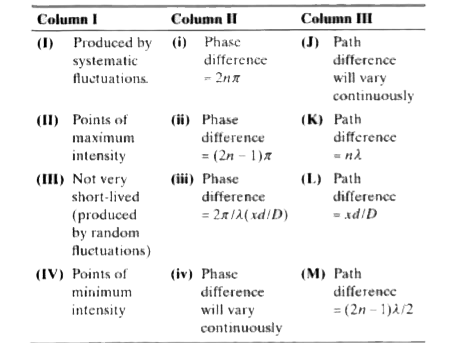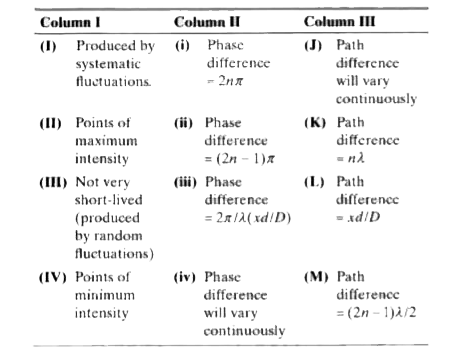The amplitudes of two coherent waves are vector quanti- ties. In the given table, Column I shows the phase differ ence between two coherent waves, Column II shows the path difference between them and Column III shows their resultant amplitudes.

When is the phasor diagram at secondary maxima?
(III) (i) (L)
(IV) (i) (J)
(III) (iv) (J)
(IV) (iv) (M)
The correct Answer is:D
(IV) (iv) (M)
Topper's Solved these Questions
- INTERFERENCE AND DIFFRACTION Book:RESNICK AND HALLIDAYChapter:INTERFERENCE AND DIFFRACTION Exercise:PRACTICE QUESTIONS (Integer Type)
Explore 6 Videos
- INTERFERENCE AND DIFFRACTION Book:RESNICK AND HALLIDAYChapter:INTERFERENCE AND DIFFRACTION Exercise:PRACTICE QUESTIONS (Matrix-Match)
Explore 1 Video
- HYDROGEN ATOMBook:RESNICK AND HALLIDAYChapter:HYDROGEN ATOMExercise:PRACTICE QUESTIONS(Integer Type)
Explore 6 Videos
- MAGNETIC FIELDS DUE TO CURRENTSBook:RESNICK AND HALLIDAYChapter:MAGNETIC FIELDS DUE TO CURRENTSExercise:Practice Question (Integer Type)
Explore 4 Videos
Similar Questions
If the phase difference between the two wave is 2π during superposition, then the resultant amplitude is
View SolutionIn each equation, there is a table having 3 columns and 4 rows. Based on the table, there are 3 questions. Each question has 4 options (a), (b), (c ) and (d), ONLY ONE of these four options is correct.
There are different types of lasers. In the given table, Colums I shows the properties of different lasers or material used in lasers, Column II shows the different names of the lasers and Column III shows the uses of different type of lasers.

What are the characteristics of semiconductor laser?
View Solution
Knowledge Check
The amplitudes of two coherent waves are vector quanti- ties. In the given table, Column I shows the phase differ ence between two coherent waves, Column II shows the path difference between them and Column III shows their resultant amplitudes.

When is the phasor diagram at primary maxima?A(I) (iii) (M)B(III) (ii) (K)C(I) (i) (L)D(I) (iii) (J)The amplitudes of two coherent waves are vector quanti- ties. In the given table, Column I shows the phase differ ence between two coherent waves, Column II shows the path difference between them and Column III shows their resultant amplitudes.

When is ER maximum?A(I) (ii) (M)B(III) (ii) (J)C(II) (ii) (K)D(II) (iv) (M)If two coherent light waves produce minima of fifth order, the path difference between the waves is-
A5λB5λ/2C7λ/2D9λ/2
Interference is an important property of light. In the given table, Column I shows the properties of interfering waves, Column II shows the phase difference, and Column III shows the path difference between two interfering waves

What are the conditions for sustained interference?
View SolutionInterference is an important property of light. In the given table, Column I shows the properties of interfering waves, Column II shows the phase difference, and Column III shows the path difference between two interfering waves

What are the conditions for constructive interference?
View SolutionIn each equation, there is a table having 3 columns and 4 rows. Based on the table, there are 3 questions. Each question has 4 options (a), (b), (c ) and (d), ONLY ONE of these four options is correct.
There are different types of lasers. In the given table, Colums I shows the properties of different lasers or material used in lasers, Column II shows the different names of the lasers and Column III shows the uses of different type of lasers.

What are the characteristics of liquid state laser?
View SolutionIn each equation, there is a table having 3 columns and 4 rows. Based on the table, there are 3 questions. Each question has 4 options (a), (b), (c ) and (d), ONLY ONE of these four options is correct.
There are different types of lasers. In the given table, Colums I shows the properties of different lasers or material used in lasers, Column II shows the different names of the lasers and Column III shows the uses of different type of lasers.

What are the characteristics of solid-state laser?
View SolutionInterference is an important property of light. In the given table, Column I shows the properties of interfering waves, Column II shows the phase difference, and Column III shows the path difference between two interfering waves

What are the conditions for destructive interference?
View Solution

